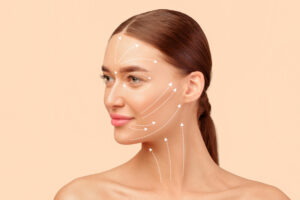Lately, there’s a phrase that keeps popping up on social media and in celebrity news: “Mar-a-Lago face.”

 4.7
4.7
Would you like to receive information about the operations from Vanity Doctors?
As Vanity, we can give you information about the operation you are considering.
Ask the DoctorSimply put, this term is used to describe a specific type of face, created through intensive cosmetic interventions, especially seen around Trump’s social circle in the United States. So it’s not about a single surgery, but more like an end-to-end “look package.”
This look usually comes from a combination of:
- Plastic surgery
- Fillers and Botox
- Cosmetic dentistry
- Heavy makeup
- Fake tan
The name comes from Donald Trump’s famous Mar-a-Lago resort in Florida. Since that venue has long been known as a meeting point for a certain wealthy and conservative elite, the facial aesthetic associated with that world has also come to be known by the same name.
In this article, we’ll look at the Mar-a-Lago face trend purely from an aesthetic and cultural perspective:
- What kind of facial look are we talking about?
- Who tends to choose this trend?
- Which procedures are used to create it?
- What does the recovery and aftercare process look like?
- What does it mean in terms of cost?
Let’s break it all down step by step, in clear and simple language.
What does the Mar-a-Lago face look like?
First, let’s picture it.
When people say Mar-a-Lago face, certain striking features come to mind. The details vary a bit from source to source, but the general picture looks like this:
- High, full cheekbones
- Very tight and ultra-smooth skin
- Full, sharply contoured lips
- A clearly defined jawline
- A relatively narrow, sculpted nose
- Noticeable lashes and intense eye makeup
- Bronzed, tanned skin
- Very whitened, perfectly aligned teeth
So in essence, it’s like a combination of a glamorous TV face and a heavily filtered social media aesthetic. Certain women close to the Trump family are often cited as examples of this look. But the important point here is this: in this article we’re focusing not on specific names, but on the shared facial template.
You shouldn’t think of the Mar-a-Lago face as just “heavy makeup.” This style is usually achieved through a long-term plan that includes:
- Surgical procedures
- Injectable treatments
- Skin and dental care
- A regular tanning routine
So rather than a simple makeup trend, it functions more like a full-scale aesthetic package.
Who finds the Mar-a-Lago face appealing?
This trend tends to become attractive mainly in certain social and professional circles.
On-screen personalities and public figures
We mostly see the Mar-a-Lago face among:
- People who frequently appear on political shows
- TV commentators and presenters
- Speakers who often appear at public events and fundraising galas
- People who are close to this world and aspire to that style
For these people, the face is almost like a business card. First impressions form in seconds, and the camera magnifies everything. That’s why looking “always groomed, ready, and energetic” becomes important. The Mar-a-Lago face offers exactly that: a very strong “stage face.”
Different expectations for women and men

This trend appears in both women and men, but the emphasis points differ slightly.
For women, the focus is usually on:
- Fuller lips
- Prominent cheekbones
- Procedures that open up the eye area
- Bronzed and “glowy” skin
The goal is to create a look that appears both glamorous and “snatched” on camera.
For men, the emphasis is more on:
- A strong jawline
- Touch-ups that reduce signs of fatigue
- A tighter, more youthful face
Areas like the lips and lashes are not accentuated as dramatically as they are in women. So while the Mar-a-Lago face pursues a similar sense of “perfection” in both genders, the roles and focal points differ.
Why is it so appealing?
Let’s take a closer look at the motivations of those who choose the Mar-a-Lago face, purely in terms of personal and professional needs.
A sense of confidence and being “always ready”
For someone constantly in front of the camera, “looking tired” can sometimes overshadow what they’re actually saying. Many people report feeling more:
- Put-together
- Awake and refreshed
- Satisfied with what they see in the mirror after aesthetic treatments.
Naturally, that boosts confidence.
There’s also a familiar pattern with trends like this: people get used to seeing smooth, bronzed, filter-perfect faces on social media. Then when they look in the mirror, the gap between that image and reality can be demoralizing. Full aesthetic “packages” like the Mar-a-Lago face become appealing as a way to shrink that gap.
Branding and image management
In television and politics, consistently maintaining a certain style matters. Face, hair, makeup, clothing…
All of it together builds a personal brand image.
From this perspective, the Mar-a-Lago face offers a face that is:
- Visually consistent from appearance to appearance
- Sharp and striking
- Easy to recognize
In other words, it helps a person achieve that “you know it’s them the second you see them” effect on any channel, which is a powerful tool in communication and branding.
A sense of group belonging
People don’t just want to look good; they also want to feel like they belong to a particular group. Similar hairstyles, similar makeup, similar dress codes. All signal “I’m part of this circle.”
You can read the Mar-a-Lago face in the same way: people who share this aesthetic language tend to see each other as more “one of us.”
The path to the Mar-a-Lago face look
Now let’s get a bit more practical. How is this look planned, and what steps are involved?
The decision-making phase
The first step is very familiar:
people take screenshots of faces they like from social media, TV shows, or news segments. Then they go to a plastic surgeon or medical aesthetics specialist with those images.
You’ll hear very concrete requests like:
“I’d like a jawline similar to this,”
“I like cheekbones shaped like these.”
Doctors then look at the patient’s facial structure and explain what is and isn’t realistically possible.
Choosing the doctor and clinic
In such a comprehensive transformation, one of the most critical factors is choosing the right physician. It’s especially important to seek out centers that offer an integrated approach and have experience and strong references in:
- Facial surgery
- Cosmetic dentistry
- Medical aesthetic procedures
For example, at Vanity, facial surgery, dental aesthetics, and medical treatments are all planned and performed under one roof by specialists in their respective fields. This allows the process to proceed in a much more controlled way in terms of both safety and aesthetic harmony.
Clinics like Vanity, which transparently share the experiences of patients from different countries and cities, along with before-and-after photos and feedback, also have a major advantage when it comes to setting realistic expectations and explaining the treatment process clearly.
Balancing expectations
The key here is realistic expectations and transparent communication. Not every trend suits every face in the same way. It’s important to avoid extremes that completely disrupt the face’s natural proportions.
At Vanity, doctors evaluate each procedure in line with the patient’s facial structure, overall health, and long-term outcome. They recommend and perform only those treatments they truly find suitable for the patient, and when they think something isn’t appropriate, they guide the patient toward alternatives that will lead to a more accurate and natural result.
Because the ultimate goal is for the patient to feel good, both physically and psychologically, over the long term. This attitude, prioritizing the patient’s benefit above all and managing the process transparently from start to finish, is one of the main reasons Vanity receives such positive feedback from its patients.
Common procedures used for the Mar-a-Lago face
The Mar-a-Lago face is not a single procedure but a combination. It varies from person to person, but we can group the most common components:
- Face and neck lift surgeries
- Brow lift
- Eyelid surgery
- Rhinoplasty (nose surgery)
- Fat grafting to the face
- Botox injections
- Dermal fillers, sometimes with layered techniques to contour certain features
- Thread lifts
- Skin resurfacing methods such as chemical peels and lasers
- Regular medical facials
- Teeth whitening and porcelain veneers
In women, more emphasis is placed on the lips, cheekbones, eye area and bronzed skin.
In men, the focus is more on the jawline, under-eye area, and overall facial tightness.
The main goal is to make all of these procedures work together as a harmonious whole. If, for example, the teeth are extremely white and the skin is very bronzed but the facial contours don’t match, the result can look artificial. Successful planning ensures that all the pieces tell the same visual story.
Some people opt to have most of these procedures done at once, while others choose to spread them out over several stages. The plan can change according to work schedule, budget, and health status.
Recovery and aftercare
As with any aesthetic intervention, the road to a Mar-a-Lago face involves a recovery period.
In the first days after surgical procedures, things like:
- Swelling
- Bruising
- Mild pain
- Limited facial expressions
are all considered completely normal. The medications and care instructions given by the doctor help make this period more comfortable.
As the first weeks pass:
- Bruising fades
- Swelling goes down
- Stitches are removed
and the person can gradually return to daily life. It usually takes a few months for the final result to fully settle in. During this time, it’s important to be patient and keep up with follow-up appointments.
In the long term, the work isn’t really “finished,” because:
- Botox needs to be refreshed at regular intervals
- Fillers are gradually absorbed by the body
- Skin care and sun protection must become routine
In other words, the maintenance side of the Mar-a-Lago face is at least as important as the operations themselves.
The cost aspect
Now to the question everyone is curious about: How much does the Mar-a-Lago face cost?
In reality, it’s impossible to give a fixed number, because the total budget depends on many factors:
- Which procedures are performed
- Which city and country they are done in
- Which doctor and clinic you choose
Full packages including several surgeries plus intensive medical aesthetics can reach high figures. On top of that, you’ll need to set aside a budget every year for maintenance such as regular Botox and filler sessions, skin care, and small touch-ups. So the Mar-a-Lago face is a long-term investment, not just a one-time expense.
However, the main decision-making factor shouldn’t be price alone. The doctor’s experience, the team’s expertise, and the clinic’s reliability are critical. After all, we’re talking about your face and your expression.
At Vanity, treatment plans are personalized according to the patient’s needs and carried out by a strong team in both surgical and medical branches. Considering Vanity’s experience and success record, along with transparent pricing, different budget options, and flexible payment plans, it becomes possible to achieve this kind of comprehensive transformation at what can be called a reasonable level.
Frequently asked questions about the Mar-a-Lago face
Let’s quickly answer some of the questions that may be on your mind.
Is this trend only related to Trump supporters?
The concept originally arose from the kind of aesthetic seen around people close to Trump. But over time, as media and popular culture picked it up, it became known by a much wider audience. Today, it can be used for anyone with a similar look. So while its roots are political, its usage has expanded beyond that.
Is this look permanent?
The surgical elements offer longer-lasting results. Changes made to areas like the face, nose, or chin can last for many years.
Parts like Botox, fillers, skin care, and tanning, however, need to be repeated at intervals. So some parts of the package are long-term, while others require ongoing maintenance.
Is it just about aesthetics, or also about identity?
There’s no single answer to this. For some, the Mar-a-Lago face is purely about external appearance and stage needs. For others, it’s a visual expression of belonging to a certain lifestyle and social circle.
In short, some people see it as “just looking good,” while others experience it as a visual answer to the questions “Who am I, and where do I belong?”
Final thoughts
In summary, the Mar-a-Lago face is a highly defined facial trend that became more visible during the Trump era and is strengthened by cosmetic interventions.
This trend combines:
- Plastic surgery
- Injectables
- Cosmetic dentistry
- Heavy makeup
- Tanning routines
to offer an attractive “ready-to-go face,” especially for people in front of the camera.
If you’re considering a transformation this comprehensive and bold, the most critical factors are: an experienced team, a strong group of physicians, and an approach that looks at the face as a whole.
With its integrated experience in facial surgery, medical aesthetics, and dental aesthetics all under one roof, Vanity is one of the best addresses for this type of full facial transformation.
Get in touch with us to ask any questions on your mind and to plan your personalized treatment process step by step, in a realistic and safe way.




